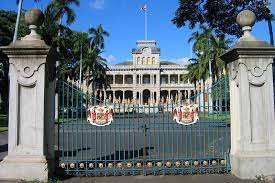Located on the island of Oahu, in downtown Honolulu, the ‘Iolani (ee-oh-LAH-nee) Palace is a historic landmark that stands as the only royal residence in the United States. ‘Iolani Palace is 7,000 square feet with 4 floors and a total of 10 rooms. Built in 1879 and completed in 1882, the palace was equipped with advanced technology and amenities during that time such as electricity, indoor plumbing, and telephones. In fact, the ‘Iolani Palace had electricity installed before the White House and Buckingham Palace. After being a place of residence for Hawaiian royalty and government officials, the palace is now a museum open to the public.
Before the ‘Iolani Palace was built, in 1845, King Kamehameha III built a large home on the land the palace is currently built on. It was later demolished and construction for the palace began in 1874. The location of the land is significant and important to the Hawaiian monarchy because the land was considered sacred and a place of worship (ancient heiau).
Initially, the palace was called “Hale Ali’i” (House of the Chief) during the reign of King Kamehameha V. Later, King Kamehameha V changed the name of the palace to “Iolani” in honor and memory of his late brother and predecessor, King Kamehameha IV (whose full name is Alexander ʻIolani Kalanikualiholiho). In the Hawaiian language, ‘Iolani means “royal hawk” as “‘Io” refers to the Hawaiian hawk and ‘lani’ meaning heavenly, royal, or someone of high status. Shortly after the palace was built, Hawaiian monarchs King Kalakaua and his wife, Queen Kapiolani, established the ‘Iolani Palace as their official residence. After King Kalakaua’s death, his sister and successor, Queen Lili’uokalani, established residency in the palace. However, in 1893, the United States government overthrew Queen Lili’uokalani and the entire Hawaiian monarchy which meant that the palace was occupied by the Hawaiian monarchy for only 11 years. After the Hawaiian kingdom was overthrown by the United States, the Hawaiian islands was officially annexed as a U.S. territory in 1898 and Hawaii officially became a state in 1959. From 1893 to 1968, the ‘Iolani Palace became a capitol building until the Hawaii State Capitol was built in 1969. For more information about the overthrow of the Hawaiian kingdom, please visit: https://www.nvlchawaii.org/hawaiian-monarchy-overthrown-territory-hawaii.
After the bombing of Pearl Harbor, the U.S. military used the ‘Iolani Palace during World War II as a military headquarters due to martial law. The ‘Iolani Palace is where the heroic 442nd Infantry unit, the Hawaiian-Japanese soldiers, swore in before entering into battle. The palace acted as military headers before it returned as captiol building for the Provisional government of Hawaii.
During the overthrow of the Hawaiian monarchy, items such as Hawaiian monarch furniture, furnishings, and artifacts were either inventoried or auctioned off. After the Hawaii State Capitol was built, a $7.5 million restoration of the palace began and was completed in 1978. Today, half of the original artifacts auctioned off have been returned and restored from owners all over the world. Inside the palace, the interior design and architecture was heavily influenced by the Italian Renaissance. King Kalakaua, also known as the “The Merry Monarch”, had a reputation for having a generous spirit and was well known for his love for the arts and lavish lifestyle. The first floor of the palace is where the Grand hall, State Dining hall, Blue room, and Throne room are located. The main focal point in the palace runs in the Grand hall where the large Hawaiian koa wood staircase leads up to the second floor. The second floor consists of private living quarters such as the King’s and Queen’s private suites, music room, the King’s library, and the infamous imprisonment room.
The imprisonment room refers to the room in the palace where Queen Lili’uokalani was placed during her house arrest imposed by the United States govenrment. During the overthrow of the Hawaiian monarchy, the United States held Queen Lili’uokalani under house arrest for 8 months after Hawaiian monarchy royalists launched a counter-revolution attempt to take back the monarchy’s control and restore the Queen’s reign.
On the outside of the ‘Iolani Palace, the palace is surrounded by four gate entrances. Each gate entrance was designated for different purposes. The Kauikeaouli entrance gate, given its name to honor King Kamehameha III, is used only for ceremonial occasions. The Kinau entrance gate was named after Princess Kina’u, who was the mother of King Kamehameha IV and King Kamehameha V, and only used by tradesmen. The Hakaleleponi entrance gate was named after Queen Kalama, the wife of King Kamehameha III, designated for staff and maintenance. Lastly, the Likelike entrance gate, named after Princess Likelike, was exclusively used by the royal Hawaiians. Now, all of the four gate entrances are open to all visitors and staff for convenience.
Today, the ‘Iolani Palace is a museum that attracts tourists and locals alike. It emphasizes the direction and history of Hawai’i and a glimpse of the transition from sovereignty to statehood. The palace is owned and maintained by the State of Hawai’i through the Department of Land and Natural Resources (DLNR). The palace also can be reserved for weddings and other private events. For more information about the ‘Iolani Palace museum and tours, please visit: https://www.iolanipalace.org/.








